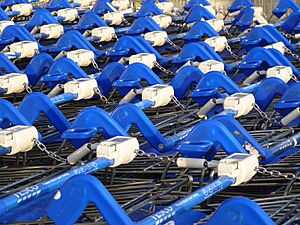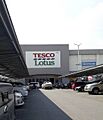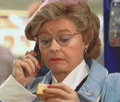Tesco facts for kids

Logo used since 1995
|
|
|
Formerly
|
|
|---|---|
| Public | |
| Traded as | LSE: TSCO FTSE 100 Component |
| ISIN | ISIN: [https://isin.toolforge.org/?language=en&isin=GB00BLGZ9862 GB00BLGZ9862] |
| Industry | Retail |
| Founded | 1919 Hackney, London, England, UK |
| Founder | Sir Jack Cohen |
| Headquarters | Tesco House, Shire Park, Kestrel Way, Welwyn Garden City, Hertfordshire, England, UK |
|
Number of locations
|
4,673 (2021) |
|
Key people
|
|
| Products |
|
| Brands |
|
| Revenue | |
|
Operating income
|
|
| Total assets | |
| Total equity | |
|
Number of employees
|
330,000 (2025) |
| Divisions |
|
Tesco plc is a huge British company that sells groceries and many other items. Its main offices are in Welwyn Garden City, England. The company was started by Sir Jack Cohen in 1919 in Hackney, London.
Tesco is the biggest supermarket chain in the United Kingdom, with a market share of about 28.4%. Besides the UK, Tesco also has stores in Ireland, Hungary, Slovakia, and the Czech Republic.
Starting in the 1960s, Tesco began selling more than just food. It added books, clothes, electronics, toys, and even petrol. It also offers services like banking, mobile phones, and internet. In the 1990s, Tesco created its "Tesco Value" range for shoppers on a budget and its "Tesco Finest" range for those wanting premium products.
Tesco is listed on the London Stock Exchange, which means people can buy and sell shares in the company.
History of Tesco
How Tesco Started
Jack Cohen started Tesco in 1919. He was the son of Jewish migrants from Poland. He began by selling extra groceries from a stall in a market in the East End of London.
The name "Tesco" first appeared in 1924. Jack Cohen bought a shipment of tea from a man named T. E. Stockwell. He used the first three letters of the supplier's name (TES) and the first two letters of his own last name (CO) to create the brand TESCO.
The very first Tesco shop opened in 1931 in Burnt Oak, Edgware. In 1948, Tesco opened its first self-service shop, where customers could pick items themselves instead of asking a shopkeeper. The first proper supermarket opened in Maldon, Essex, in 1956.
Growing Bigger
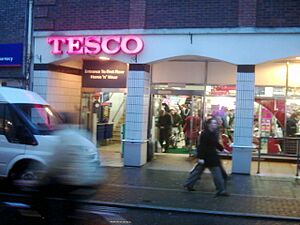
During the 1950s and 1960s, Tesco grew by opening new shops and buying other shop chains. By the end of the 1960s, it owned more than 800 shops. Jack Cohen's motto was "pile it high and sell it cheap".
In 1994, Tesco bought the supermarket chain William Low, which helped it expand into Scotland. A year later, in 1995, Tesco introduced its popular Clubcard loyalty scheme and started an internet shopping service.
In 1997, Tesco bought the company that owned Quinnsworth, Stewarts, and Crazy Prices in Ireland and Northern Ireland. This made Tesco a major retailer in Ireland.
Selling More Than Just Food
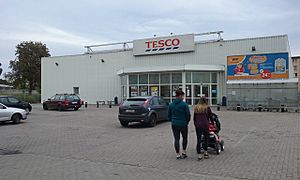
Tesco began to sell a wider variety of items in the 1960s, including clothes and household goods. In 1974, it opened its first petrol station.
Over the years, Tesco expanded into many new areas. It started offering financial services through Tesco Bank and mobile phone services with Tesco Mobile. It also tried opening stores in other countries, including the United States with a chain called Fresh & Easy, but this was not successful and the stores closed in 2013.
In 2017, Tesco merged with Booker Group, the UK's largest food wholesaler. This meant Tesco could supply food to many smaller shops, cafes, and restaurants.
Tesco in the United Kingdom
As of April 2024, Tesco had thousands of stores across the UK. These stores come in different sizes and formats.
| Format | Number | Total area (sq ft) |
Percentage of space |
|---|---|---|---|
| Large Store (Extra and Superstore) | 809 | 31,092,000 | 66.8% |
| Convenience (Express) | 2,094 | 5,615,000 | 12.1% |
| Dotcom only | 6 | 716,000 | 1.5% |
| One Stop | 730 | 1,205,000 | 2.6% |
| Booker | 190 | 7,951,000 | 17.1% |
| Total | 3,829 | 46,579,000 | 100.00% |
Types of Tesco Stores
Tesco Extra
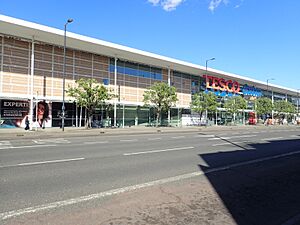
Tesco Extra stores are huge hypermarkets, usually found on the edge of towns. They sell almost everything Tesco offers, from food and clothes to electronics and furniture. The largest Tesco Extra in England is in Walkden, near Manchester.
Tesco Superstores
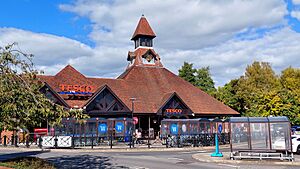
These are standard large supermarkets. They mainly sell groceries but also have a smaller selection of non-food items compared to Tesco Extra stores. Many of these stores also have a cafe.
Tesco Express
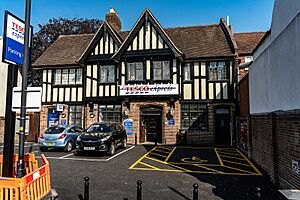
Tesco Express shops are small convenience shops found in city centres, neighbourhoods, and on Esso petrol station forecourts. They sell everyday essentials and snacks. Prices can sometimes be slightly higher in Express stores because they cost more to run.
One Stop
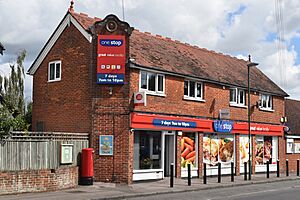
One Stop is another chain of convenience shops owned by Tesco. These shops are often in local communities and do not have the Tesco name on them. This sometimes causes confusion, as many customers don't realise they are owned by Tesco.
Other UK Services
Online Shopping
Tesco has a popular home shopping service through its website, Tesco.com. In fact, one of the world's first-ever online grocery purchases was made from a Tesco shop in 1984 using a technology called Videotex. Today, many people use the website or app to get their groceries delivered.
Tesco Clubcard
The Tesco Clubcard is a loyalty scheme launched in 1995. Shoppers collect points for every pound they spend. These points can be turned into vouchers to save money on shopping or used for deals on days out, holidays, and more. The Clubcard was a big reason why Tesco became so popular.
Tesco's Other Businesses
Tesco Bank
Tesco offers financial services like credit cards, loans, savings accounts, and insurance through Tesco Bank. This part of the business started as a partnership with The Royal Bank of Scotland, but Tesco bought the whole company in 2008.
F&F Clothing
F&F is Tesco's clothing brand, which launched in 2001. It was originally called Florence & Fred. You can find F&F clothing in larger Tesco stores and also buy it online through a partnership with the retailer Next PLC.
Tesco Mobile
Tesco Mobile is a mobile phone network that uses O2's infrastructure. It launched in 2003 and has millions of customers in the UK. It also operates in Ireland, Slovakia, Hungary, and the Czech Republic.
Tesco Around the World
Tesco has stores in several countries outside the UK. The company tries to adapt to local tastes by working with local partners.
- Ireland: Tesco is one of the largest supermarket chains in Ireland, with over 150 stores.
- Central Europe: Tesco has a strong presence in the Czech Republic, Hungary, and Slovakia, with hundreds of stores across these countries.
Former International Operations
Over the years, Tesco has also left several countries. It sold its businesses in the United States (Fresh & Easy), Japan, China, Poland, South Korea, and Thailand. This was often because the stores were not making enough money or because Tesco wanted to focus on its main markets.
Corporate Information
How Tesco Appeals to Shoppers
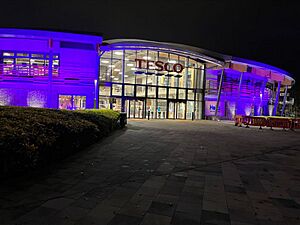
Tesco's strategy is to appeal to all types of customers. It does this by offering different product ranges:
- Tesco Value (now replaced by brands like "Exclusively at Tesco"): Low-cost products for shoppers on a tight budget.
- Tesco brand: Mid-range products that offer good quality and value.
- Tesco Finest: High-quality, premium products for special occasions.
The company's main slogan is "Every little helps," which has become very well-known.
Tesco is the market leader in the UK grocery market. In early 2025, it held about 28.5% of the market. This means that for every £10 spent on groceries in the UK, about £2.85 is spent at Tesco. Its main competitors are Sainsbury's, Asda, Aldi, and Lidl.
Images for kids
-
A 24-hour Tesco petrol station in Oldham, Greater Manchester, England, 2009.
-
A local Tesco Express, known as Tesco Expres, in Prague, Czech Republic.
-
A Tesco store in Bratislava, Slovakia, 2008.
-
A Tesco Metro store in Jesmond, Newcastle upon Tyne, England, 2016. This brand is no longer used.
-
A Dobbies Garden Centre in Lasswade, Scotland, 2007. Tesco owned Dobbies for several years.
-
The inside of a Jack's supermarket in Chatteris, Cambridgeshire, England, 2018. This budget chain was closed in 2022.
-
A Tesco Extra store in Johor Bahru, Malaysia, 2019. Tesco sold its Malaysian business in 2020.
-
A Tesco store in Kraków, Poland, 2006. Tesco left Poland in 2021.
-
A Kipa Extra store in Çiğli, İzmir, Turkey, 2023. Tesco sold its Turkish business in 2017.
-
Actress Prunella Scales played the character Dotty Turnbull in popular Tesco adverts.
See also
 In Spanish: Tesco para niños
In Spanish: Tesco para niños
- List of supermarket chains in the United Kingdom
- Tesco Town
- Tesco Everyday Value


